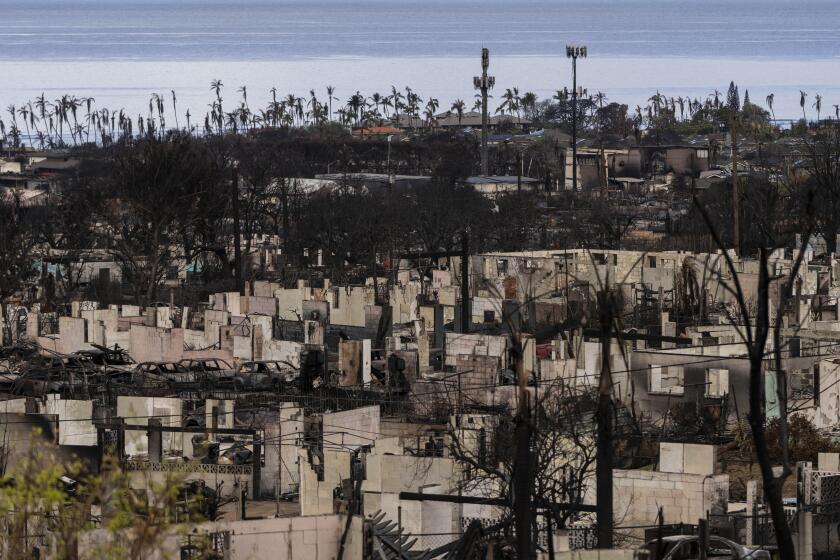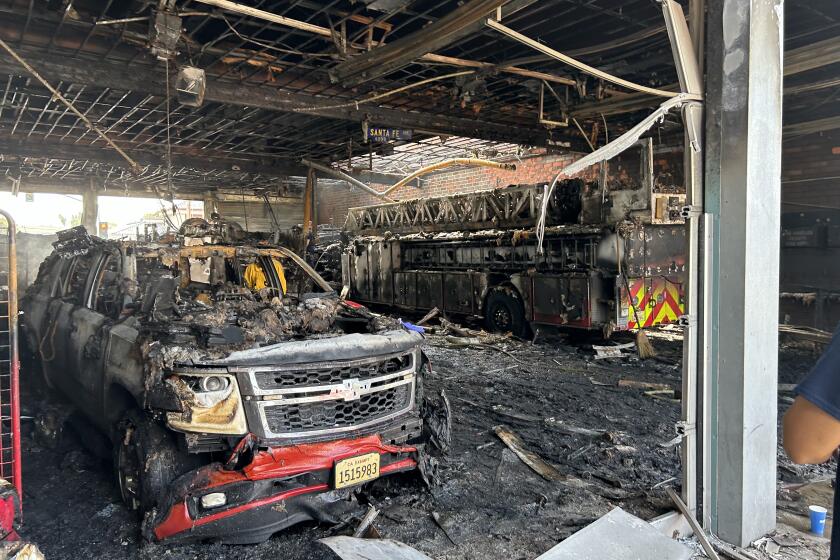Newport Firefighter Who Battled ’87 Chemical Blaze Dies of Cancer
Fire Capt. Al Schmehl, the longest surviving of three Newport Beach emergency workers stricken with cancer after one of the worst hazardous-materials fires in Southern California history, has succumbed to the illness.
Schmehl, 52, died last week at a residential care facility in Lake Forest, prompting grief and fear through Orange County’s firefighting community.
“This is as traumatic and significant to us as if the roof caved in,” said Rich Thomas, president of the Newport Beach Firefighters Assn. and a colleague of Schmehl’s who fought the infamous 1987 fire alongside him. “Though it’s a longer process,” he said, “it’s no less real than if one of our members was caught in a building’s collapse or anything else that might take our lives.”
Schmehl and Thomas were among about 80 firefighters and police officers who responded to the chemical blaze at a Newport Beach metal plating plant 16 years ago. Three of them -- firefighter Larry Parrish, police officer Steve Van Horn and now Schmehl -- developed cancer afterward and died.
Though there has never been a scientifically established link between their illnesses and the toxic chemicals they encountered that day at the Hixson Metal plant, there is little doubt within the closely knit Newport Beach fire community that it played at least some role in their deaths.
“We had very significant exposures during that fire,” Thomas said, “not only from the smoke and fire but in the runoff from the building. It was bad -- I was absolutely covered in chemicals.”
Firefighters pumped about 65,000 gallons of water into the Hixson plant, as noxious black smoke filled the sky and a stream of purple liquid oozed into the street. Because of the chemical contamination, the city had to dispose of all the fire hoses used on the fire. Boots and gloves worn by police officers were ordered destroyed. Apartment buildings were evacuated.
In 1992, Parrish became the first to be diagnosed with cancer. His colon cancer quickly spread to his liver and, in 1993, the firefighter and fitness buff died. Van Horn was diagnosed with leukemia in 1995 and died two years later.
In 1996, Schmehl, already suffering from brain tumors, told The Times that he did not regret the risks he took during his career.
“It’s my job to go into places where things are bad, like at Hixson,” Schmehl said. “If there’s a spill or gas or fire, everybody else leaves and I go in. That’s the job. And I know the risks. I’m prepared for whatever happens.”
Even though he could have taken a medical retirement years earlier, Schmehl worked until March of this year.
“He loved this department so much that the last thing he wanted to do was retire,” Newport Beach Fire Chief Timothy Riley said.
Schmehl’s passing recalls the Hixson fire and the toll it may have taken on the city’s emergency workers. Riley said he can’t say for sure that the toxins Schmehl was exposed to in 1987 caused his cancer, but he said it’s likely Schmehl’s career in firefighting contributed to his illness.
“It leads to a little melancholy in the department. A lot of us have been exposed to things. It really is a silent killer,” the chief said. “It does cause us to pause and think about what this could mean to us and our families. It makes us think about the potential risks we face when we go out and do this type of work.”
Drake Muat, who retired from the Newport Beach Fire Department in 2000, was the first firefighter on scene at the Hixson blaze.
Afterward, he hosted a national conference to help train firefighters on handling chemical fires.
If the Hixson fire didn’t specifically cause Schmehl’s cancer, it was a contributing factor, Muat said.
All fires, even home fires, are potentially hazardous for firefighters, he said.
“Do we dwell on it and does it impact how we respond to anything? No. It’s part of the best job in the world,” he said. “You go in because there’s people trapped and you want to rescue them.”
The illnesses do, however, cause some concern among firefighters.
“We just keep waiting to find out who’s going to be next,” Muat said.
*
Times staff writer Stuart Pfeifer contributed to this report.
More to Read
Start your day right
Sign up for Essential California for news, features and recommendations from the L.A. Times and beyond in your inbox six days a week.
You may occasionally receive promotional content from the Los Angeles Times.






